Check out the TEN content marketing KPI you can use to drive better content marketing decisions and get more meaningful results.
Check out the TEN content marketing KPI you can use to drive better content marketing decisions and get more meaningful results.
If you want to remain competitive online currently and in the future, you must have a compelling and effective content marketing strategy. It allows for highly engaging and low-cost media that attract more leads and build a positive image of your brand.
However, one of the challenges of content marketing is the difficulty in tracking your strategy’s success. It could be due to unsure which metric you should measure or track.
So today, we are going to see the fundamental content marketing KPI you can use.
Let’s dive right in.
What Are KPIs and Why Are They Important?
What is KPI in marketing?
Here is the KPI marketing definition:
A Key Performance Indicator (KPI) refers to a measurable number or factor that you can analyze over a specific period and a predetermined methodology.
They make your progress MUCH easier to measure.
The progress can be positive or negative.
Either way, KPIs for content marketing will help you understand what you’re doing right or what you’re doing wrong regarding your content marketing strategy.
When you learn how to leverage KPIs, you have more opportunities to make decisions based on reliable information.
This way, you will always be ahead of the competition when it comes to content marketing.
Here is the list of content marketing KPI I’m talking about:
The Most Important Content Marketing KPI You Should Be Tracking
Content Score
There is no definitive standard for content to be “successful.”
It can vary widely depending on the project and purpose as well as organizational processes and goals.
A content scoring system comes in handy in this department. A content score is simply a consistent methodology that can allow you to make qualitative assessments of your assets.
In this case, Content Intelligence is a great place to start.
Content Intelligence is an AI-powered tool that analyzes your content and provides crucial insights into its effectiveness. Here is how it looks like:

The tool breaks down your content and analyzes it based on some key factors, including relevancy, sentiments, readability, and much, much more.
- Relevancy –indicates how relevant a piece of content is to your targeted keywords.
- Sentiment – indicates the ration of sentiments in a section of your content, including positive, neutral, or negative.
- Readability – tells you how easy it is to read your content.
- Semantic density – tells you how relevant your content is with the targeted keywords.
- Keyword density – shows how many times you repeat the targeted keyword in your content.
Scroll to the bottom, and you will see the three different scores you can use to determine your content performance further.
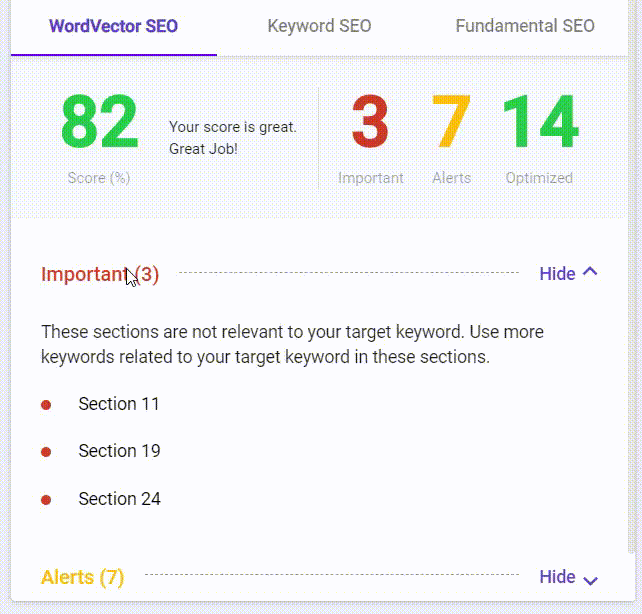
Let’s go through each one of them.
You can use the WordVector score to tell whether your content is relevant against the top 10 rankings. The higher the WordVector score is, the better it is.

In the Keyword SEO, the score tells you the overall SEO score based on your target keyword.
I recommend you to start fixing the critical errors to increase your Keyword SEO score.

Lastly, in Fundamental SEO, you will see the overall SEO score based on your content performance.

You may use the performance indicator to help you create content with a good impact. Keep on optimizing your content and expect to see new traffic and better ranking ahead.
Keyword Rankings
Your keyword rankings indicate where major search engines like Google and Bing position your target keywords.
A higher ranking signifies that you are putting out high-quality content. The closer you are to number one, the better.
It is even much better if your website ranks higher for high-volume keywords. These are the terms that users search for frequently.
Use Rank Tracking to track your keyword performance.
Enter your domain name and all the keywords that you want to track. The tool will automatically help you keep track of your ranking keywords.
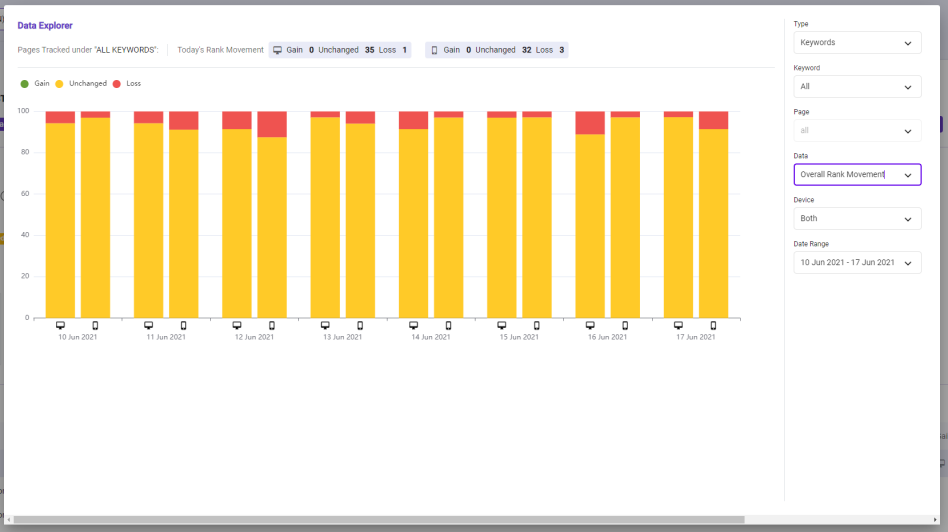
At a glance, you will be able to see:
- daily rank movement
- top 5 keywords with most gain and losses
- desktop and mobile ranking movement
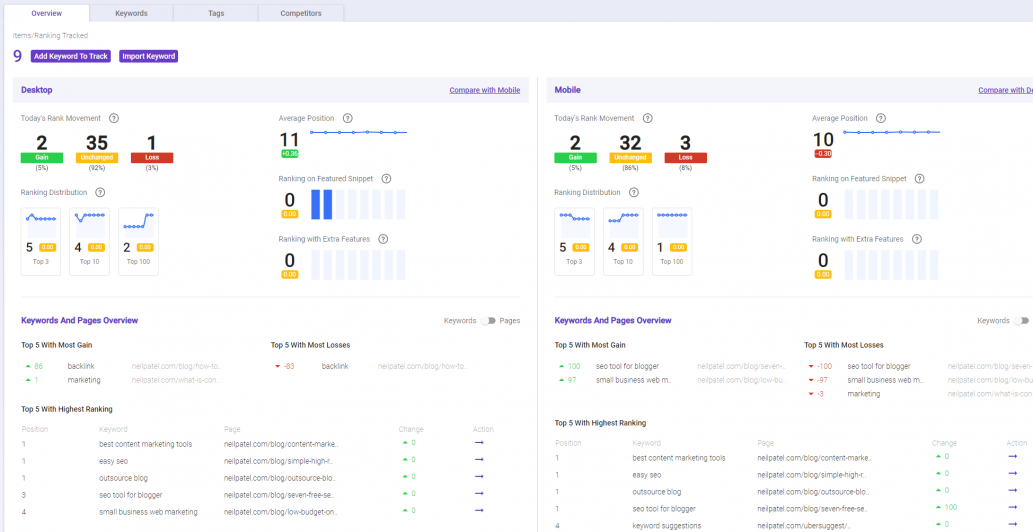
If you are unsure which keywords to track, start with discovering your ranking keywords in the Rank Intelligence.
In short, Rank Intelligence is a powerful rank checker tool that does more than just showing your ranking keywords.
It shows you the total number of keywords you are ranking for and your ranking distribution.
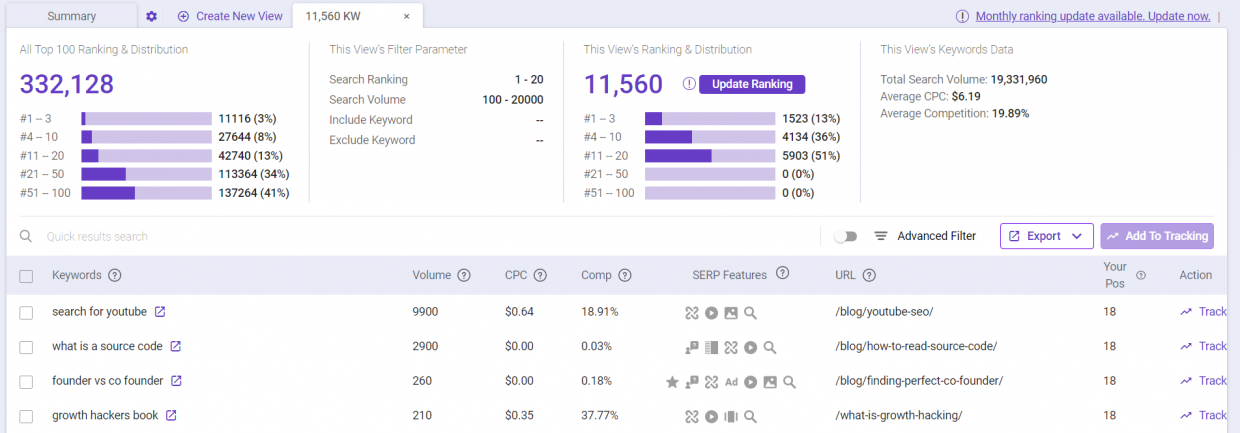
Other than that, you will also see each ranking keyword comes with its essential insight. You may use these insights to help you discover any low-hanging fruit. Then, optimize them to improve their ranking.
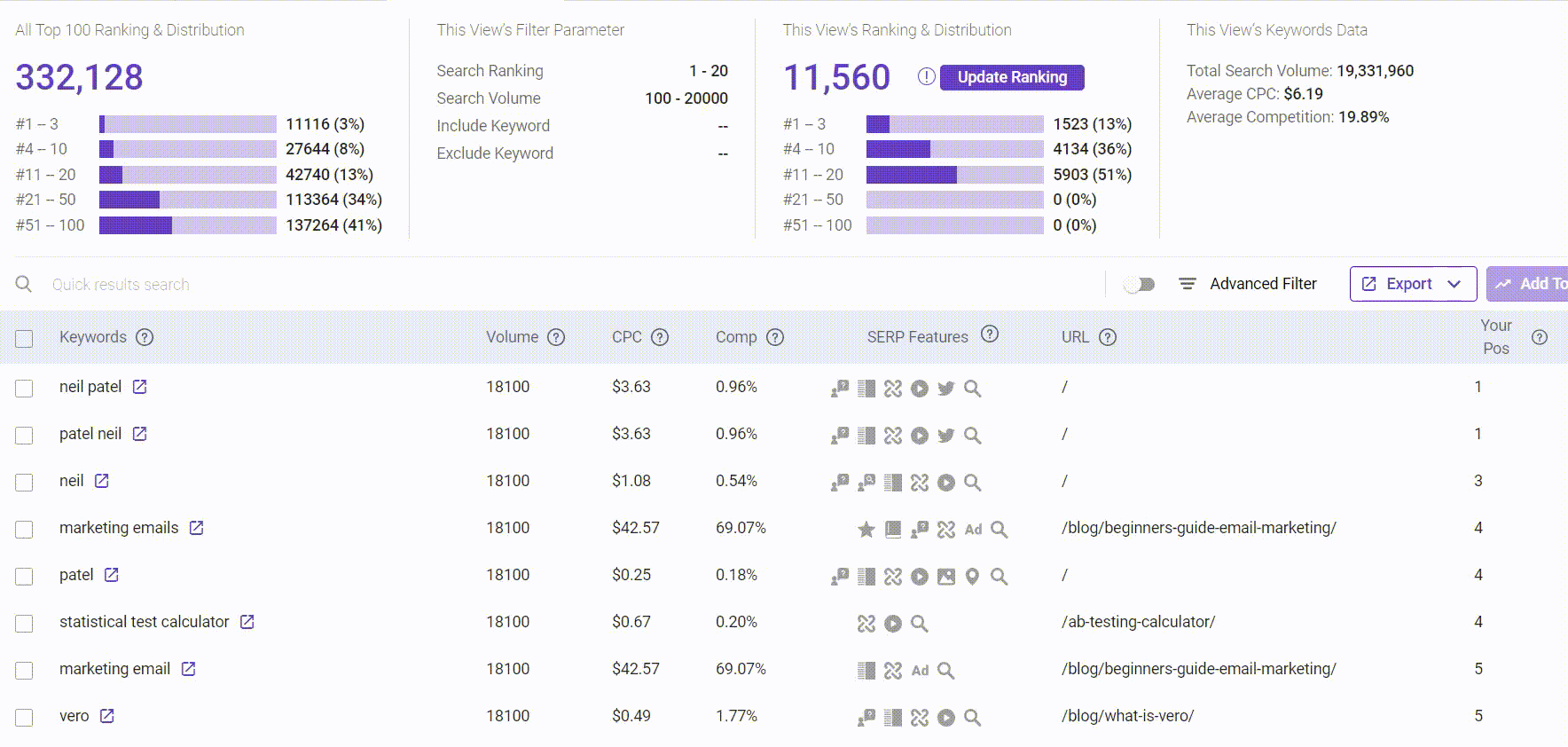
You can start tracking the keywords by selecting and adding them to the Rank Tracking.
Ranking higher for some high-volume keywords requires a long-term strategy as you gain visibility for highly competitive keywords with high commercial intent. Keyword ranking is an important KPI since many marketers and clients correlate SEO success with keyword ranking.
If you improve your keyword ranking, it opens up your doors to achieve your other primary objectives, including increased traffic, leads, and eventually sales.
It’s good practice to analyze your keyword rankings at least weekly (if not daily). A drop in your keyword rankings could indicate a problem with your strategy that you must address.
Page Rankings
Your web page rankings on Search Engine Results Pages (SERPs) are metrics that show your pages’ value and how well you have optimized them. This KPI is also an indicator of the type of topic authority your overall website has earned.
You may continue using Rank Tracking to check your page rankings.
Just switch to the Pages tab, and you will see the pages that you are tracking together with the number of keywords tracked.

Click the individual page, and you will see the list of keywords it is ranking for.
Your content has to provide answers to users’ queries for your pages to rank well. Ensure that you create and optimize your content to answer user queries. In the long –term, this will give you better chances than trying to rank for keywords.
Unique Page Visits
Unique page visits are a metric that shows the number of different IP addresses touched (visited) the web pages (assuming each of them is a unique human).
This content marketing KPI offers you insight into how popular or compelling the content on a web page is. Unique page visits also indicate how aware web users are of your actual site.
You can use Google Analytics to assess this metric. It is good practice to exclude the IP addresses of web service personnel and your employees. Doing this offers you a cleaner number such that you’re only looking at customers and potential customers. If you are using Chrome, you may install the ‘Block Your Analytics’ extension.
Ideally, you should assess this KPI and make reports monthly. Another important metric that is related to this KPI is page views per session.

You can assess spikes and lags in this number to give you an idea of what’s causing them. For instance, a spike in unique page visits may mean that you are disseminating engaging content that keeps visitors on your site longer. Lags in this metric can mean that you need to develop a stronger content calendar.
Time on Page
Google Analytics defines “time on page” as the length of time, in seconds, that a visitor spends on a certain web page. The analytical tool calculates this time by subtracting the initial view time for a page from another subsequent page’s initial view time.
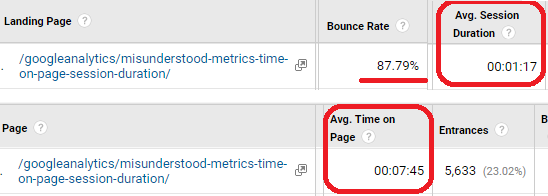
This content marketing KPI is crucial since it’s an indicator of your content’s quality and relevancy, and user engagement.
So, how long should your time on a page be? What should you be aiming for with your content?
Generally, the industry standard for “time on page” is between two to three minutes.
At first glance, two to three minutes can seem like a short time. Capitalize My Title estimates that it takes about 1 minute to read 300 words. Three minutes is enough time for your visitors to read through your content and interact with your site.
Longer times on the page signify that your audience is more engaged with your content. The reporting frequency for this KPI should be at least weekly.
Creating high-quality, useful, and engaging content to increase your time on the page is essential if you want to reduce your bounce rate. Below are some tips to achieve this:
- Disseminate content that people want to keep reading
- Improve visitor experience by restructuring your content
- Add to your content
- Add interactivity options/features.
Click-Through Rate
Your Click-Through Rate (CTR) is the ratio of your website visitors who click on specific links to the total number of visitors who view a page, advertisement, or email.
So what’s a good click-through rate?
The short answer, again, there is no magic number.
But here is the average CTR in Google Ads by industry to give you some idea of how others are doing:

Content marketing aims to elicit some action, whether making a purchase, subscribing to a service, or even watching a video.
In essence, generating leads. Content Marketing Institute reported that 85 percent of marketers have lead generation as their main business goal. If your content includes links to generate leads (which it should have), it’s important to track CTR on your pages.
If you see that some of your content has a higher CTR than others, you should analyze this content and determine what makes it perform better.
You can then apply this insight across all your content. When more users click through your content funnel, the chances of follow-up and engagement improve significantly.
Conversion Rate
Your website is the hardest working salesperson in your employ today.
It directs the users you want to engage with you and converts them into a profitable audience. The main purpose of your website and the content within and surrounding it is conversion.
To give a quick sense of where you stand, here is the average conversion rate across all industries:

As such, the conversion rate is among the most important content marketing metrics you should be tracking. Your conversion rate indicates the percentage of your visitor that transact with you. The conversions you measure can be anything from product purchases, email list opt-ins, form submissions, and service subscriptions.

How you define a conversion will depend on the nature of your business or website. Conversion rate is a primary metric that will help you evaluate how your content marketing initiatives are performing.
You can use Google Analytics to assess your conversion rate. Note that you can use other techniques or tools to track the number of quality conversions your content leads to.
Cost per Click
Cost per Click (CPC) is a very important KPI to track if you promote your content through Pay per Click (PPC) advertisement or sponsored social ads. CPC is one of those metrics that correlate with dollar signs.
You can evaluate how well you are doing by comparing yourself to the industry average CPC. Here are the average CPC in AdWords across all industries:

CPC is a major factor determining the return on investment (ROI) of your content marketing initiatives. You can measure your CPC by dividing the cost of an advertisement campaign by the number of times users clicked an ad in the campaign.
If your ad content is relevant to your audience, your CPC will be lower. Relevant content also helps achieve better overall campaign results since you are reaching your audience with content that they are interested in.
Cost per Lead
Cost per lead (CPL) or cost per acquisition (CPA) is a metric measuring your content marketing campaigns’ efficiency when generating leads for your sales funnel. This KPI offers insight into whether you are getting new customers/clients in a cost-efficient way.

CPL allows you to set your marketing and sales goals, calculate your estimated ROI, and set your advertising budgets. You determine your CPL by the total cost of acquiring one lead.
There are different ways that you can measure CPL. One formula is dividing your monthly customer acquisition costs by the number of leads per month. You can categorize leads according to the type of business.
Social Sharing
Social sharing is the modern digital equivalent of word-of-mouth marketing. It is a measure of the number of times your content is shared on social networking platforms. Social shares help expose your brand and connect you with customers.
Here are some statistics by RivallQ about the average engagement rate per post on Facebook and Instagram across all industries:


When your content resonates with people, you will have high engagement levels in social shares. They not only signify the popularity of your posts, but they also increase your content’s reach.
When a single user shares your content, that content will appear on the feed of all the user’s followers. The way your content performs on social media is a great indicator of its effectiveness.
A great way to assess your social shares is to utilize the native analytical tools that each social media platform provides. Facebook has the Insights tab, and Twitter has Twitter Analytics. You can view your data on Instagram and Pinterest through your business accounts on those platforms.
Choosing the Content Marketing KPIs to Track
Not all content marketing KPIs and metrics will be relevant or valuable to your overall strategy.
Below are some points you have to consider when deciding which KPIs you should track:
- Match specific business goals to KPIs and metrics
- Be flexible when determining content KPIs
- Consider both on-site and off-site metrics
- Apply your insight and take action
- Focus on the actionable content KPIs
- Share content insights with all members/departments of your organization/business
- Avoid obsessing over single data points.
Conclusion
Tracking and acting on your content marketing KPI is an important part of any content marketing strategy. Formulating a basis for measuring your performance is equally crucial.
It helps account for how you spend your marketing resources and offer valuable insights into how your content drives your business goals at various levels.
You must measure content performance, not just at the transactional points but also at all the touchpoints in your customers’ journey.
Let me know which content marketing KPI are you currently using in the comment below!




